[English] 日本語
 Yorodumi
Yorodumi- PDB-5m5c: Mechanism of microtubule minus-end recognition and protection by ... -
+ Open data
Open data
- Basic information
Basic information
| Entry | Database: PDB / ID: 5m5c | ||||||
|---|---|---|---|---|---|---|---|
| Title | Mechanism of microtubule minus-end recognition and protection by CAMSAP proteins | ||||||
 Components Components |
| ||||||
 Keywords Keywords | TRANSPORT PROTEIN / CAMSAP CKK Microtubule Tubulin | ||||||
| Function / homology |  Function and homology information Function and homology informationMicrotubule-dependent trafficking of connexons from Golgi to the plasma membrane / Cilium Assembly / Intraflagellar transport / : / Sealing of the nuclear envelope (NE) by ESCRT-III / Kinesins / Resolution of Sister Chromatid Cohesion / Mitotic Prometaphase / EML4 and NUDC in mitotic spindle formation / COPI-dependent Golgi-to-ER retrograde traffic ...Microtubule-dependent trafficking of connexons from Golgi to the plasma membrane / Cilium Assembly / Intraflagellar transport / : / Sealing of the nuclear envelope (NE) by ESCRT-III / Kinesins / Resolution of Sister Chromatid Cohesion / Mitotic Prometaphase / EML4 and NUDC in mitotic spindle formation / COPI-dependent Golgi-to-ER retrograde traffic / COPI-independent Golgi-to-ER retrograde traffic / COPI-mediated anterograde transport / RHO GTPases activate IQGAPs / RHO GTPases Activate Formins / microtubule minus-end binding / MHC class II antigen presentation / HSP90 chaperone cycle for steroid hormone receptors (SHR) in the presence of ligand / Aggrephagy / The role of GTSE1 in G2/M progression after G2 checkpoint / Separation of Sister Chromatids / Loss of Nlp from mitotic centrosomes / Recruitment of mitotic centrosome proteins and complexes / Loss of proteins required for interphase microtubule organization from the centrosome / Anchoring of the basal body to the plasma membrane / AURKA Activation by TPX2 / Recruitment of NuMA to mitotic centrosomes / Regulation of PLK1 Activity at G2/M Transition / Hedgehog 'off' state / regulation of cell morphogenesis / positive regulation of axon guidance / spectrin binding / regulation of microtubule polymerization / microtubule-based process / cytoplasmic microtubule / cytoskeleton organization / cellular response to interleukin-4 / structural constituent of cytoskeleton / microtubule cytoskeleton organization / neuron migration / neuron projection development / mitotic cell cycle / double-stranded RNA binding / microtubule cytoskeleton / microtubule binding / Hydrolases; Acting on acid anhydrides; Acting on GTP to facilitate cellular and subcellular movement / microtubule / calmodulin binding / cilium / hydrolase activity / protein heterodimerization activity / GTPase activity / ubiquitin protein ligase binding / GTP binding / metal ion binding / cytosol / cytoplasm Similarity search - Function | ||||||
| Biological species |  Homo sapiens (human) Homo sapiens (human) | ||||||
| Method | ELECTRON MICROSCOPY / single particle reconstruction / cryo EM / Resolution: 4.8 Å | ||||||
 Authors Authors | Akhmanova, A. / Moores, C.A. / Baldus, M. / Steinmetz, M.O. / Topf, M. / Roberts, A.J. / Grant, B.J. / Scarabelli, G. / Joseph, A.-P. / van Hooff, J.J.E. ...Akhmanova, A. / Moores, C.A. / Baldus, M. / Steinmetz, M.O. / Topf, M. / Roberts, A.J. / Grant, B.J. / Scarabelli, G. / Joseph, A.-P. / van Hooff, J.J.E. / Houben, K. / Hua, S. / Luo, Y. / Stangier, M.M. / Jiang, K. / Atherton, J. | ||||||
 Citation Citation |  Journal: Nat Struct Mol Biol / Year: 2017 Journal: Nat Struct Mol Biol / Year: 2017Title: A structural model for microtubule minus-end recognition and protection by CAMSAP proteins. Authors: Joseph Atherton / Kai Jiang / Marcel M Stangier / Yanzhang Luo / Shasha Hua / Klaartje Houben / Jolien J E van Hooff / Agnel-Praveen Joseph / Guido Scarabelli / Barry J Grant / Anthony J ...Authors: Joseph Atherton / Kai Jiang / Marcel M Stangier / Yanzhang Luo / Shasha Hua / Klaartje Houben / Jolien J E van Hooff / Agnel-Praveen Joseph / Guido Scarabelli / Barry J Grant / Anthony J Roberts / Maya Topf / Michel O Steinmetz / Marc Baldus / Carolyn A Moores / Anna Akhmanova /     Abstract: CAMSAP and Patronin family members regulate microtubule minus-end stability and localization and thus organize noncentrosomal microtubule networks, which are essential for cell division, polarization ...CAMSAP and Patronin family members regulate microtubule minus-end stability and localization and thus organize noncentrosomal microtubule networks, which are essential for cell division, polarization and differentiation. Here, we found that the CAMSAP C-terminal CKK domain is widely present among eukaryotes and autonomously recognizes microtubule minus ends. Through a combination of structural approaches, we uncovered how mammalian CKK binds between two tubulin dimers at the interprotofilament interface on the outer microtubule surface. In vitro reconstitution assays combined with high-resolution fluorescence microscopy and cryo-electron tomography suggested that CKK preferentially associates with the transition zone between curved protofilaments and the regular microtubule lattice. We propose that minus-end-specific features of the interprotofilament interface at this site serve as the basis for CKK's minus-end preference. The steric clash between microtubule-bound CKK and kinesin motors explains how CKK protects microtubule minus ends against kinesin-13-induced depolymerization and thus controls the stability of free microtubule minus ends. | ||||||
| History |
|
- Structure visualization
Structure visualization
| Movie |
 Movie viewer Movie viewer |
|---|---|
| Structure viewer | Molecule:  Molmil Molmil Jmol/JSmol Jmol/JSmol |
- Downloads & links
Downloads & links
- Download
Download
| PDBx/mmCIF format |  5m5c.cif.gz 5m5c.cif.gz | 336.8 KB | Display |  PDBx/mmCIF format PDBx/mmCIF format |
|---|---|---|---|---|
| PDB format |  pdb5m5c.ent.gz pdb5m5c.ent.gz | 267.6 KB | Display |  PDB format PDB format |
| PDBx/mmJSON format |  5m5c.json.gz 5m5c.json.gz | Tree view |  PDBx/mmJSON format PDBx/mmJSON format | |
| Others |  Other downloads Other downloads |
-Validation report
| Summary document |  5m5c_validation.pdf.gz 5m5c_validation.pdf.gz | 1.2 MB | Display |  wwPDB validaton report wwPDB validaton report |
|---|---|---|---|---|
| Full document |  5m5c_full_validation.pdf.gz 5m5c_full_validation.pdf.gz | 1.3 MB | Display | |
| Data in XML |  5m5c_validation.xml.gz 5m5c_validation.xml.gz | 53.3 KB | Display | |
| Data in CIF |  5m5c_validation.cif.gz 5m5c_validation.cif.gz | 78.4 KB | Display | |
| Arichive directory |  https://data.pdbj.org/pub/pdb/validation_reports/m5/5m5c https://data.pdbj.org/pub/pdb/validation_reports/m5/5m5c ftp://data.pdbj.org/pub/pdb/validation_reports/m5/5m5c ftp://data.pdbj.org/pub/pdb/validation_reports/m5/5m5c | HTTPS FTP |
-Related structure data
| Related structure data |  3444MC  4154C  4156C 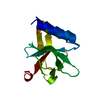 5lznC  5m50C  5m54C C: citing same article ( M: map data used to model this data |
|---|---|
| Similar structure data |
- Links
Links
- Assembly
Assembly
| Deposited unit | 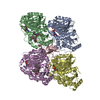
|
|---|---|
| 1 |
|
- Components
Components
-Protein , 3 types, 5 molecules CDAEB
| #1: Protein | Mass: 13550.654 Da / Num. of mol.: 1 / Fragment: UNP residues 1472-1589 / Mutation: N1492A Source method: isolated from a genetically manipulated source Source: (gene. exp.)  Homo sapiens (human) / Gene: CAMSAP1 / Production host: Homo sapiens (human) / Gene: CAMSAP1 / Production host:  | ||
|---|---|---|---|
| #2: Protein | Mass: 48638.793 Da / Num. of mol.: 2 / Source method: isolated from a natural source / Source: (natural)  #3: Protein | Mass: 47809.746 Da / Num. of mol.: 2 / Source method: isolated from a natural source / Source: (natural)  |
-Non-polymers , 5 types, 16 molecules 


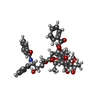





| #4: Chemical | | #5: Chemical | #6: Chemical | #7: Chemical | #8: Water | ChemComp-HOH / | |
|---|
-Experimental details
-Experiment
| Experiment | Method: ELECTRON MICROSCOPY |
|---|---|
| EM experiment | Aggregation state: FILAMENT / 3D reconstruction method: single particle reconstruction |
- Sample preparation
Sample preparation
| Component |
| ||||||||||||||||||||||||
|---|---|---|---|---|---|---|---|---|---|---|---|---|---|---|---|---|---|---|---|---|---|---|---|---|---|
| Source (natural) |
| ||||||||||||||||||||||||
| Source (recombinant) | Organism:  | ||||||||||||||||||||||||
| Buffer solution | pH: 6.8 / Details: BRB80 | ||||||||||||||||||||||||
| Specimen | Embedding applied: NO / Shadowing applied: NO / Staining applied: NO / Vitrification applied: YES / Details: 13pf Microtubules | ||||||||||||||||||||||||
| Specimen support | Grid material: COPPER / Grid type: C-flat-2/2 | ||||||||||||||||||||||||
| Vitrification | Instrument: FEI VITROBOT MARK III / Cryogen name: ETHANE |
- Electron microscopy imaging
Electron microscopy imaging
| Experimental equipment |  Model: Tecnai Polara / Image courtesy: FEI Company |
|---|---|
| Microscopy | Model: FEI POLARA 300 |
| Electron gun | Electron source:  FIELD EMISSION GUN / Accelerating voltage: 300 kV / Illumination mode: FLOOD BEAM FIELD EMISSION GUN / Accelerating voltage: 300 kV / Illumination mode: FLOOD BEAM |
| Electron lens | Mode: BRIGHT FIELD |
| Image recording | Electron dose: 25 e/Å2 / Detector mode: COUNTING / Film or detector model: GATAN K2 SUMMIT (4k x 4k) / Details: 25e-/A2 used in final reconstuctions |
| EM imaging optics | Energyfilter name: GIF |
- Processing
Processing
| Software | Name: PHENIX / Version: 1.11.1_2575: / Classification: refinement | ||||||||||||||||||||||||
|---|---|---|---|---|---|---|---|---|---|---|---|---|---|---|---|---|---|---|---|---|---|---|---|---|---|
| EM software |
| ||||||||||||||||||||||||
| CTF correction | Type: PHASE FLIPPING AND AMPLITUDE CORRECTION | ||||||||||||||||||||||||
| Particle selection | Num. of particles selected: 4144 | ||||||||||||||||||||||||
| 3D reconstruction | Resolution: 4.8 Å / Resolution method: FSC 0.143 CUT-OFF / Num. of particles: 6530 Details: Gold-standard noise substitution test used to assess for over fitting (Chen et al., 2013) Symmetry type: POINT | ||||||||||||||||||||||||
| Atomic model building | Protocol: OTHER | ||||||||||||||||||||||||
| Refine LS restraints |
|
 Movie
Movie Controller
Controller


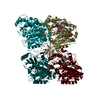
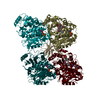

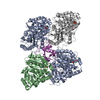
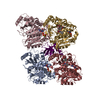
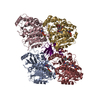
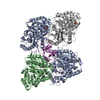

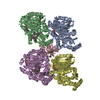

 PDBj
PDBj








